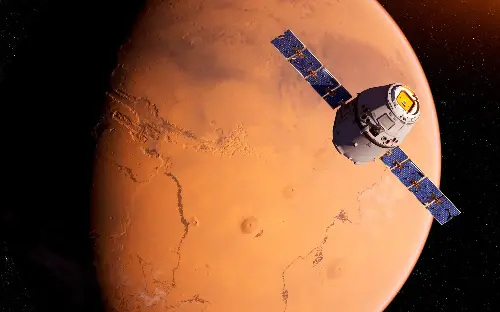
Mars once had the appearance of a prime holiday spot, with sun-soaked sandy beaches and gentle, lapping waves, scientists have found.
Experts believe an ancient northern ocean, dubbed “The Gulf of Mars,” covered nearly half the planet four billion years ago and was surrounded by sweeping shorelines similar to those on Earth.
It comes after ground-penetrating radar data from China’s Zhurong Mars rover picked up thick layers of sand pointing upwards from the former seabed at a 15-degree angle – nearly identical to the slope of beach deposits on Earth.
“We’re finding places on Mars that used to look like ancient beaches and ancient river deltas,” said Dr Benjamin Cardenas, study author and assistant professor of geology at Penn State University in the US.
“We found evidence for wind, waves, no shortage of sand – a proper, vacation-style beach.”
The discovery indicates that, for tens of millions of years, Mars was a warm and wet planet where life could have thrived.
Dr Cardenas added: “When we look back at where the earliest life on Earth developed, it was in the interaction between oceans and land, so this is painting a picture of ancient habitable environments, capable of harbouring conditions friendly toward microbial life.”
The Zhurong rover landed on Mars in 2021 in an area known as Utopia Planitia and sent back data on the geology of its surroundings as it searched for signs of ancient water or ice.
Utopia Planitia is one of the largest impact basins on Mars and had long been hypothesised to have once contained an ancient ocean.
Unlike other rovers, Zhurong’s radar technology allowed it to penetrate 260 feet beneath the Martian soil and identify buried rock formations.
The data revealed a similar layered structure to beaches on Earth, in formations called “foreshore deposits” that slope upwards from oceans and form when sediments are carried by tides.
The ancient beaches were found around 30 feet beneath the surface after being covered over billions of years by dust storms, as well as material thrown up by asteroid impacts and volcanic eruptions.
Deposits of this thickness on Earth would have taken millions of years to form, suggesting that Mars had a long-lived body of water with wave action to distribute the sediments along a sloping shoreline.
The radar data was also able to determine the size of the particles in the layers, which matched that of sand. However, the deposits did not resemble ancient, wind-blown dunes, which are common on Mars today.
Study co-author Dr Michael Manga, professor of Earth and planetary science at the University of California, Berkeley, said: “The structures don’t look like sand dunes. They don’t look like an impact crater. They don’t look like lava flows. That’s when we started thinking about oceans.
“The orientation of these features are parallel to what the old shoreline would have been. They have both the right orientation and the right slope to support the idea that there was an ocean for a long period of time to accumulate the sand-like beach.”
The presence of beaches implies a large, ice-free ocean once existed on Mars, even though the planet is too cold for liquid water today following the loss of its atmosphere.
Dr Hai Liu, a core member of the scientific team behind the Zhurong rover’s Tianwen-1 mission, said: “This strengthens the case for past habitability in this region on Mars.”
Researchers also believe the sand sediments must have come from ancient rivers which flowed into the ocean.
The findings were published in the journal Proceedings of the National Academy of Sciences.
